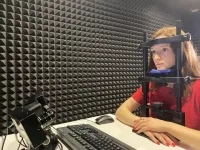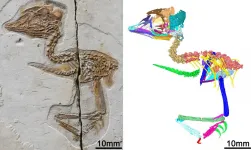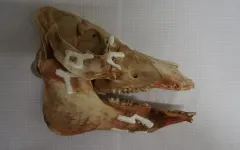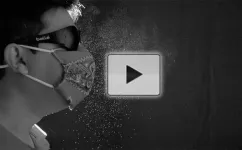Researchers outline specific patterns in reading in Russian
Psycholinguists from the HSE University investigated how reading in Russian varies among different groups of readers
2021-06-23
(Press-News.org) Psycholinguists from the HSE Center for Language and Brain, in collaboration with researchers from the City University of New York and the University of Stuttgart, investigated how reading in Russian varies among different groups of readers. The authors used a novel method in bilingualism research -comparison of the eye-movement sequences (scanpaths) in adult native speakers of Russian, Russian-speaking children, and adult bilinguals with different levels of Russian proficiency. The results of the study were published in Reading Research Quarterly.
A total of 120 readers took part in the study, with 30 participants in each group. Participants included adult native Russian speakers, second-grade Russian primary school students, students at American universities who study Russian as a foreign language (RFL), and, finally, heritage-language speakers. The last group included bilingual individuals who either were born in a Russian-speaking family in the USA or emigrated with their families at an early age from a Russian-speaking country. This means that Russian is an "inherited" mother tongue for them, although in most cases, it becomes a non-dominant language in a later childhood when they learn the new language of their environment (i.e., English). All participants read the same simple sentences in Russian (such as 'Andrey bought milk, cheese and sour cream in a store.') while their eye movements were recorded.
The authors found that each group of readers has a specific reading pattern. Adult native speakers exhibit a 'fluent' scanpath reading process: they read fast (2 seconds per sentence), fixate on the words for a short time (290 ms), rarely regress to words, and often skip them (17% of all words in a sentence). The researchers suggest that such pattern reflects 'effortless' reading: adult native speakers do not encounter any difficulties in visual word recognition or in processing the grammatical structure of sentences.
Reading patterns for second-graders are completely different. They take more time to read a sentence (6 seconds per sentence), fixate words for a longer time (690 ms), re-read words more often and skip them less often (9%). The researchers defined this pattern as an 'intermediate' reading process. Following the conclusions from previous reading studies involving children, the researchers believe that the intermediate pattern reflects difficulties experienced by children at the local lexical level: beginner readers are not as efficient as adults in decoding letters into sounds. Such inefficiency hinders visual recognition of words and, accordingly, slows down the lexical access to the child's 'mental lexicon' (i.e., the connection between the written word and its oral representation).
To compare reading patterns, the authors of the paper used cluster analysis, which showed that heritage speakers with higher levels of Russian proficiency also read following the intermediate pattern. However, RFL students and heritage speakers with lower language skills demonstrate a third, 'beginner' reading pattern. It is characterized by the longest fixation time on words (1,054 ms), the longest time per sentence (14 seconds), frequent re-reading of words and a low probability of skipping them (6%).
The main characteristic of the beginner pattern is re-reading big portions of sentences or whole sentences twice or more times (up to 5-6 times in some cases). The researchers suggest that such a pattern reflects not only the local difficulties in lexical access, but also the global problems with understanding written language, particularly difficulties in general information integration and comprehension of the grammatical structure of the sentences.
'The fact that bilingual heritage speakers had acquired Russian early (similar to native speakers they learn it from the birth), did not impact the development of their Russian reading skills. Even the advanced heritage speakers follow the same reading pattern as children of 8-9 years old, said Olga Parshina, researcher at the HSE Center for Language and Brain.
According to the authors, to be a member of the particular group of readers does not always mean to follow a single reading pattern. Many children and heritage speakers (and sometimes, RFL students) read sentences following different patterns, which means that readers can switch from one process to another.
'We will continue looking at linguistic and individual factors that impact the process of this switching. In the future, we hope that results will help teachers to boost the process of switching while teaching students to read,' said Anastasiya Lopukhina, researcher at the Center for Language and Brain.
INFORMATION:
[Attachments] See images for this press release:

ELSE PRESS RELEASES FROM THIS DATE:
2021-06-23
BUFFALO, N.Y. -- The giant plumose anemone is an animal, but it looks a bit like an underwater cauliflower. Its body consists of a stalk-like column that attaches to rocks and other surfaces on one end, and to a crown of tentacles on the other.
The anemones use these feelers to collect and shove food into their mouths, and a new study provides an in-depth look into the rich diversity of prey the anemones are catching. This includes a surprising menu item: ants, specifically the pale-legged field ant, Lasius pallitarsis. And the occasional spider.
The research was published on June 15 in the journal Environmental DNA. The study focused on giant plumose ...
2021-06-23
How long do virus-laden particles persist in an elevator after a person infected with COVID-19 leaves? And is there a way to detect those particles? A group of electrical engineers and computer scientists at KAUST set out to answer these questions using mathematical fluid dynamics equations.
"We found1 that virus-laden particles can still be detected several minutes after a short elevator trip by an infected person," says KAUST electrical engineer Osama Amin.
The team's equations and breath simulations suggest that a biosensor's ability to detect a virus improves when placed on an elevator wall that can reflect particles. Also, to protect future occupants, the amount of particles in the air can be reduced by making the other three walls absorptive.
Amin ...
2021-06-23
COLUMBIA, Mo. - Throughout her 20-year career as a nurse practitioner, Jennifer Hulett noticed survivors of breast cancer would often express gratitude for being alive and mention God or a divine acknowledgement that had improved their health and well-being.
Now an assistant professor at the University of Missouri Sinclair School of Nursing, Hulett is researching the benefits of spirituality on improving immune health and reducing stress, as well as the chances of cancer reoccurrence, among breast cancer survivors.
In a recent study, Hulett collected and froze samples of saliva from 41 breast cancer survivors at MU's Ellis Fischel Cancer Center. ...
2021-06-23
Researchers from the Institute of Vertebrate Paleontology and Paleoanthropology (IVPP) of the Chinese Academy of Sciences have discovered a 120-million-year-old partial fossil skeleton of a tiny extinct bird that fits in the palm of the hand and preserves a unique skull with a mix of dinosaurian and bird features.
The two-centimeter-long (0.75 inch) skull of the fossil shares many structural and functional features with the gigantic Tyrannosaurus rex, indicating that early birds kept many features of their dinosaurian ancestors and their skulls functioned much like those of dinosaurs rather than living ...
2021-06-23
MINNEAPOLIS/ST. PAUL (06/23/2021) -- A new report from the University of Minnesota Medical School's Healthy Youth Development - Prevention Research Center (HYD-PRC) highlights that Minnesota youth continue to contract sexually transmitted infections (STIs) at alarmingly high rates, despite the COVID-19 pandemic.
The 2021 Minnesota Adolescent Sexual Health Report says that chlamydia and gonorrhea rates among Minnesota adolescents in 2020 are likely underreported, as both STI testing and case detection were scaled back during the early stages of the pandemic. However, teen pregnancy rates remain virtually unchanged from 2018, and birth rates are at historic lows for ...
2021-06-23
The stink of ammonia in urine, sweat, and rotting meat repels humans, but many insects find ammonia alluring. Now, UConn researchers have figured out how the annoying insects smell it, a discovery that could lead to better ways to make them buzz off.
The sense of smell is enormously important. Mammals devote a third of their genetic code to odor receptors found in the nose, and have more than 1,000 different kinds that allow us to smell an estimated trillion different odors.
Flies don't have noses. Instead, they smell with their antenna. Each antenna is covered with tiny hairs called sensilla. Each sensilla contains a few neurons--fly brain cells. Each neuron expresses one type of odor receptor, and they all fall into two main ...
2021-06-23
A new biocompatible polymer-based composite material could soon replace metal plates in treating difficult and unstable fractures. Developed at KTH Royal Institute of Technology in Stockholm, the newly-developed material is as strong as dental composites yet non-toxic.
The material and a surgical method, which were published in Advanced Functional Materials, will be used in clinical studies in 2023 and 2024, with a focus on hand fractures.
Michael Malkoch, professor of fibre and polymer technology at KTH, says that the material and method, AdhFix, will enable customized plating for fixation of fractures with a more comfortable, less complicated recovery. Collarbone and rib fractures in particular are ideally suited for the proposed treatment, ...
2021-06-23
During the COVID-19 pandemic, cloth face masks became a way to help protect yourself and others from the virus. And for some people, they became a fashion statement, with many fabric choices available. But just how effective are they, especially in containing a sneeze? Now, researchers reporting in ACS Biomaterials Science & Engineering used high-speed videos of a person sneezing to identify the optimal cloth mask design. Watch a video of the sneeze cam here.
Early in the pandemic, worldwide shortages of surgical masks and N95 respirators led many people to make or purchase cloth face masks. Now, with safe and effective COVID-19 vaccines available, mask restrictions are ...
2021-06-23
A new study published in the Journal of the Association for Consumer Research posits that increased accessibility to anthropomorphized luck (i.e., "lady luck") can lead consumers to be more likely to pursue higher-risk financial behavior. In "Lady Luck: Anthropomorphized Luck Creates Perceptions of Risk-Sharing and Drives Pursuit of Risky Alternatives," authors Katina Kulow, Thomas Kramer, and Kara Bentley propose that preferences for higher-risk options (like lottery tickets with worse odds or investment opportunities with a low chance of return) are driven by shared risk perceptions that might engender feelings of security provided by the idea of "lady luck." This behavior, the authors note, "bodes ill for consumer welfare, given that many financial maladaptive activities ...
2021-06-23
Beyond how much cream and sugar to add to their morning brew, coffee lovers also face more serious decisions: one of those is whether or not to buy ecolabelled coffee, which advertises itself as more ethical and environmentally friendly. But whether customers are willing to pay the extra price for these perks remains an unanswered question. In a study publishing in the journal Heliyon on June 23, researchers combined data from 22 studies to conclude that in general, people are willing to pay $1.36 more for a pound of coffee that's produced in an eco-friendly way and are especially partial to coffee that's labelled "Organic."
"We hear in the media or sometimes read in the newspaper that there ...
LAST 30 PRESS RELEASES:
[Press-News.org] Researchers outline specific patterns in reading in Russian
Psycholinguists from the HSE University investigated how reading in Russian varies among different groups of readers






